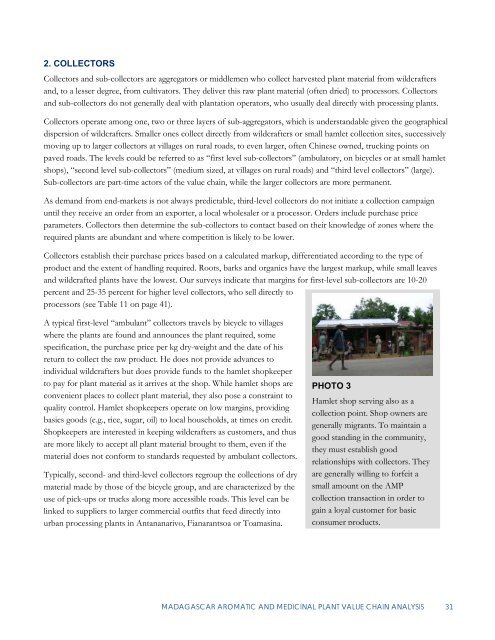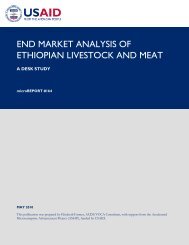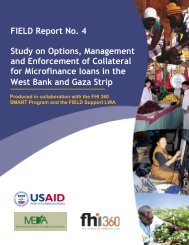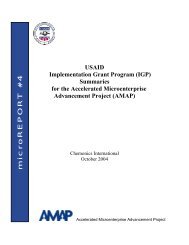Madagascar Aromatic and Medicinal Plants Value - Microlinks
Madagascar Aromatic and Medicinal Plants Value - Microlinks
Madagascar Aromatic and Medicinal Plants Value - Microlinks
You also want an ePaper? Increase the reach of your titles
YUMPU automatically turns print PDFs into web optimized ePapers that Google loves.
2. COLLECTORS<br />
Collectors <strong>and</strong> sub-collectors are aggregators or middlemen who collect harvested plant material from wildcrafters<br />
<strong>and</strong>, to a lesser degree, from cultivators. They deliver this raw plant material (often dried) to processors. Collectors<br />
<strong>and</strong> sub-collectors do not generally deal with plantation operators, who usually deal directly with processing plants.<br />
Collectors operate among one, two or three layers of sub-aggregators, which is underst<strong>and</strong>able given the geographical<br />
dispersion of wildcrafters. Smaller ones collect directly from wildcrafters or small hamlet collection sites, successively<br />
moving up to larger collectors at villages on rural roads, to even larger, often Chinese owned, trucking points on<br />
paved roads. The levels could be referred to as “first level sub-collectors” (ambulatory, on bicycles or at small hamlet<br />
shops), “second level sub-collectors” (medium sized, at villages on rural roads) <strong>and</strong> “third level collectors” (large).<br />
Sub-collectors are part-time actors of the value chain, while the larger collectors are more permanent.<br />
As dem<strong>and</strong> from end-markets is not always predictable, third-level collectors do not initiate a collection campaign<br />
until they receive an order from an exporter, a local wholesaler or a processor. Orders include purchase price<br />
parameters. Collectors then determine the sub-collectors to contact based on their knowledge of zones where the<br />
required plants are abundant <strong>and</strong> where competition is likely to be lower.<br />
Collectors establish their purchase prices based on a calculated markup, differentiated according to the type of<br />
product <strong>and</strong> the extent of h<strong>and</strong>ling required. Roots, barks <strong>and</strong> organics have the largest markup, while small leaves<br />
<strong>and</strong> wildcrafted plants have the lowest. Our surveys indicate that margins for first-level sub-collectors are 10-20<br />
percent <strong>and</strong> 25-35 percent for higher level collectors, who sell directly to<br />
processors (see Table 11 on page 41).<br />
A typical first-level “ambulant” collectors travels by bicycle to villages<br />
where the plants are found <strong>and</strong> announces the plant required, some<br />
specification, the purchase price per kg dry-weight <strong>and</strong> the date of his<br />
return to collect the raw product. He does not provide advances to<br />
individual wildcrafters but does provide funds to the hamlet shopkeeper<br />
to pay for plant material as it arrives at the shop. While hamlet shops are<br />
convenient places to collect plant material, they also pose a constraint to<br />
quality control. Hamlet shopkeepers operate on low margins, providing<br />
basics goods (e.g., rice, sugar, oil) to local households, at times on credit.<br />
Shopkeepers are interested in keeping wildcrafters as customers, <strong>and</strong> thus<br />
are more likely to accept all plant material brought to them, even if the<br />
material does not conform to st<strong>and</strong>ards requested by ambulant collectors.<br />
Typically, second- <strong>and</strong> third-level collectors regroup the collections of dry<br />
material made by those of the bicycle group, <strong>and</strong> are characterized by the<br />
use of pick-ups or trucks along more accessible roads. This level can be<br />
linked to suppliers to larger commercial outfits that feed directly into<br />
urban processing plants in Antananarivo, Fianarantsoa or Toamasina.<br />
PHOTO 3<br />
Hamlet shop serving also as a<br />
collection point. Shop owners are<br />
generally migrants. To maintain a<br />
good st<strong>and</strong>ing in the community,<br />
they must establish good<br />
relationships with collectors. They<br />
are generally willing to forfeit a<br />
small amount on the AMP<br />
collection transaction in order to<br />
gain a loyal customer for basic<br />
consumer products.<br />
MADAGASCAR AROMATIC AND MEDICINAL PLANT VALUE CHAIN ANALYSIS 31





